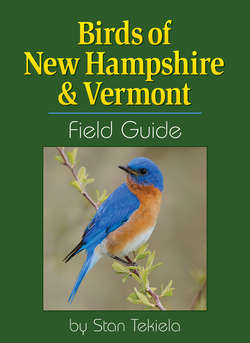Читать книгу Birds of New Hampshire & Vermont Field Guide - Stan Tekiela - Страница 21
На сайте Литреса книга снята с продажи.
Оглавлениеfemale
male
Eastern Towhee
Pipilo erythrophthalmus
SUMMER
| Size: | 7-8" (18-20 cm) |
| Male: | Mostly black with dirty red brown sides and a white belly. Long black tail with a white tip. Short, stout, pointed bill and rich red eyes. White wing patches flash in flight. |
| Female: | similar to male, but is brown, not black |
| Juvenile: | light brown with heavily streaked head, chest and belly, long dark tail with a white tip |
| Nest: | cup; female builds; 2 broods per year |
| Eggs: | 3-4; creamy white with brown markings |
| Incubation: | 12-13 days; female incubates |
| Fledging: | 10-12 days; male and female feed young |
| Migration: | complete, to southern states, South America |
| Food: | insects, seeds, fruit; visits ground feeders |
| Compare: | Slightly smaller than the American Robin, which lacks the white belly. The Gray Catbird lacks the black head and rusty sides. Common Grackle lacks a white belly and has a long thin bill. Male Rose-breasted Grosbeak has a rosy patch in the center of its chest. |
Stan’s Notes: Common name comes from its distinctive “tow-hee” call given by both sexes. Mostly known for its characteristic call that sounds like, “Drink-your-tea!” Seen hopping backward with both feet (bilateral scratching), raking up leaf litter for insects and seeds. The female broods, but the male does most of the feeding of young. In southern coastal states, some have red eyes; others have white eyes. The red-eyed variety is seen in New Hampshire and Vermont.
